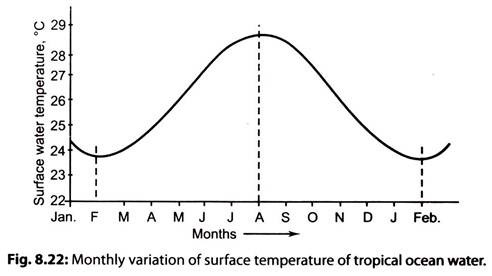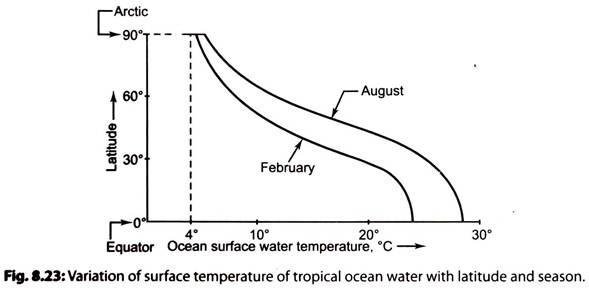Are you looking for an essay on ‘Ocean Thermal Energy Conversion’? Find paragraphs, long and short essays on ‘Ocean Thermal Energy Conversion’ especially written for school and college students.
Essay on Ocean Thermal Energy Conversion
Essay Contents:
- Essay on the Introduction to Ocean Thermal Energy Conversion
- Essay on the Working Principle of Ocean Thermal Energy Conversion (OTEC)
- Essay on the Efficiency of Ocean Thermal Energy Conversion (OTEC)
- Essay on Solar Energy Absorption by Water (Lambert’s Law of Absorption)
- Essay on the Advantages and Disadvantages of Ocean Thermal Energy Conversion (OTEC)
- Essay on the Applications of Ocean Thermal Energy Conversion (OTEC)
- Essay on the Development of OTEC Plants
Essay # 1. Introduction to Ocean Thermal Energy Conversion:
The oceans cover about 70% of the global surface and are particularly extensive in the tropical zones. Therefore, most of the sun’s radiations are absorbed by sea water. Thus ‘warm water’ (low density due to higher temperature) on the ocean’s surface flows from tropics towards poles.
‘Cold water’ (high density due to low temperature) circulates at the ocean bottom from the poles to tropics. Hence, in tropical regions, the water temperature is around 5°C at a depth of 1000 m, whereas at the surface, it remains almost constant at 25°C (range being 24°C to 27°C) for the first few metres because of mixing, subsequently it decreases and asymptotically approaches the value at the lower level.
Power obtained from OTEC plant is renewable and eco-friendly. The plant can operate in remote islands and sea shore continuously. According to MNRE, the overall potential of ocean energy in India may be in excess of 50,000 MW, and as such there is an enormous opportunity to this renewable source of energy.
Essay # 2. Working Principle of Ocean Thermal Energy Conversion (OTEC):
The principle of OTEC is that “there is a temperature difference between water at the bottom of the sea and water at the top”, this temperature difference can be used to operate a heat engine. Most of the radiation is being absorbed at the surface layer of water.
The mixing between hot and cold water is prevented because no thermal convection occurs between hot and cold water layers. This means that the surface layer will act as a “source” and cold layers act as a “sink”. Therefore, it is essential to connect the reversible heat engines between source and cold sink to produce work that can be converted into required applications.
Essay # 3. Efficiency of Ocean Thermal Energy Conversion (OTEC):
The maximum efficiency of a heat engine working between two temperature limits cannot be more than that of a Carnot cycle operating between the same temperature limits.
The Carnot cycle efficiency, in the range of temperatures of warm water (T1) in the upper surface layer and cold water (T2) in the depth of the tropical ocean, is given by:
It is only a theoretical value, but in actual practical is about 2% only. Example 8.4: Determine the overall efficiency of an ocean thermal energy conversion plant if the temperature of water in the surface layer is 26°C and the temperature of cold water in the depth of the tropical ocean is 8°C. Assume the relative efficiency factor of the power plant 0.35.
Solution:
Given: T1 = 26 + 273 = 299 K; T2 = 8 + 273 = 281 K;
Efficiency factor, EF = 0.35.
Overall efficiency, ηOTEC:
Essay # 4. Solar Energy Absorption by Water (Lambert’s Law of Absorption):
Solar energy absorption by water takes place according to Lambert’s law of absorption which states:
Each layer of equal thickness absorbs the same fraction of light that passes through it.
where, I0 = Intensity of radiation at the surface (y = 0),
I(y) = Intensity of radiation at depth y from water surface and falls exponentially with depth, and
μ = Extinction or absorption coefficient.
For very fresh clear water, p = 0.05 m-1
For turbid fresh water, p = 0.27 m-1
For very salty water, p = 0.50 m-1
Almost all of the absorption occurs very close to the surface of deep waters. Owing to heat and mass transfer at the surface itself, the maximum temperatures occur first below the surface.
i. With the increase in temperature, the density of water decreases; pure water at 3.98°C has the ‘maximum density’.
ii. There will be no convective currents between the ‘warmer’, lighter water at the top and ‘cooler’, heavier water at a depth.
Similarly, heat transfer by thermal conduction between water layers at the surface and a depth is too low to alter the picture and the mixing is retarded. The ‘warm water’ stays at the top and ‘cool water at’ the bottom.
iii. In tropical waters there are essentially “two infinite reservoirs”:
(i) A ‘heat source’ at about 27°C, and
(ii) A ‘heat sink’ at about 4°C, at some depth of 1000 m.
Both these reservoirs are maintained annually by solar incidence. These temperatures vary with latitude and season.
Fig. 8.22 and 8.23 illustrate the variation of ocean surface water temperatures with latitude and season.
Essay # 5. Advantages and Disadvantages of Ocean Thermal Energy Conversion (OTEC):
Following are the advantages, disadvantages, limitations and applications of OTEC:
Advantages of Ocean Thermal Energy Conversion:
1. It is clean form of energy conversion.
2. It does not occupy land areas.
3. No payment for the energy required.
4. It can be a steady source of energy since the temperatures are almost steady.
Disadvantages / Limitations of Ocean Thermal Energy Conversion:
1. About 30 percent of the power generated would be used to pump water.
2. The system would have to withstand strong convective effect of sea water; hurricanes and presence of debris and fish contribute additional hazard.
3. The materials used will have to withstand the highly corrosive atmosphere and working, fluid.
4. Construction of floating power plants is difficult.
5. Plant size is limited to about 100 MW due to large size of components.
6. Very heavy investment is required.
As an example for a 150 MW plant:
i. A flow of 500 m /s would be required;
ii. The heat exchangers area required will be about 0.5 km;
iii. A cold duct of 700 m length with a dia. of 25 m would be required.
Essay # 6. Applications of Ocean Thermal Energy Conversion (OTEC):
1. A closed cycle OTEC plant can also act as a chemical treatment plant.
2. An OTEC plant can also be used to pump up the deep ocean water and this cold water may be used for cooling houses, air-conditioning systems etc.
3. The enclosing area of OTEC can be used for aquaculture and mariculture.
4. The deep ocean cold water is rich in nutrients and can be used for various applications.
5. OTEC plants are quite suitable for cogeneration of electricity and fresh water.
OTEC power generation is a multipurpose project producing and supplying several useful products, like the river valley multipurpose projects.
Essay # 7. Development of OTEC Plants:
Development of OTEC in India:
The National Institute of Ocean technology is implementing the world’s first 1 MW floating OTEC technology demonstration project off the Tutocorin coast in Tamil Nadu.
i. The various subsystems for the plant have been configured, designed and integrated on an OTEC floating barge.
ii. A 1 km long cold water pipe has been towed to the site and deployed vertically with an anchoring system at a depth of 1.2 km.
The resource potential of India is estimated around 180 x 103 MW.
In 1979, the first OTEC power plant was installed in the Hawai state of the USA:
i. It was a prototype 50 kW floating plant operated on closed Rankine cycle principle with NH3 as the working fluid.
ii. It was designed with the ocean water temperature difference of 21°C.
iii. The net power available was only 15 kW, as 35 kW was consumed in pumping the warm and cold water.
In 1981, another plant was installed in Nauru (Japan) in the Central Pacific ocean.
i. It was on-land plant and was economical in construction.
ii. It required a 945 m long pipeline for pumping cold water.
iii. Its gross power capacity was 100 kW, operated with a sea water temperature difference of 21.7°C. The net output power was 31.5 kW.
iv. The turbine used was an axial flow type with 3000 rpm, the generator was directly coupled and supplied power at 415 V, 50 Hz.




